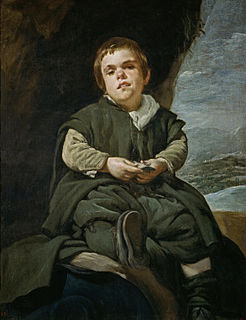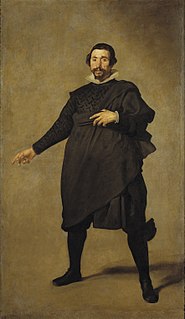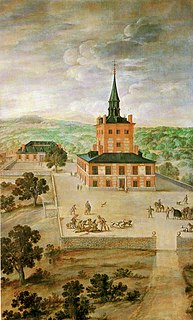
Diego Rodríguez de Silva y Velázquez was a Spanish painter, the leading artist in the court of King Philip IV and of the Spanish Golden Age. He was an individualistic artist of the contemporary Baroque period. He began to paint in a precise tenebrist style, later developing a freer manner characterized by bold brushwork. In addition to numerous renditions of scenes of historical and cultural significance, he painted scores of portraits of the Spanish royal family and commoners, culminating in his masterpiece Las Meninas (1656).

A jester, court jester, or fool, was historically an entertainer during the medieval and Renaissance eras who was a member of the household of a nobleman or a monarch employed to entertain guests. Jesters were also itinerant performers who entertained common folk at fairs and town markets. Jesters are also entertainers who perform at modern-day historically themed events.

John R. Velazquez is a Puerto Rican jockey in Thoroughbred horse racing. He began his career in Puerto Rico and moved to New York in 1990. In 2004 and 2005 he was the United States Champion Jockey by earnings and both years was given the Eclipse Award for Outstanding Jockey. He was inducted into the Horse Racing Hall of Fame in 2012, rode his 5,000th winner in 2013, and became the leading money-earning jockey in the history of the sport in 2014.
Events from the year 1639 in art.
Events from the year 1620 in art.
A jester is a type of entertainer.

The Jester Barbarroja is an oil on canvas portrait by Diego Velázquez of Cristóbal de Castañeda y Pernia, nicknamed Barbarroja in his role as a jester at the court of Philip IV of Spain from 1633 to 1649. The painting is now in the Museo del Prado. It was in the Palacio del Buen Retiro in Madrid in 1701 and from 1816 to 1827 it was in the Real Academia de Bellas Artes de San Fernando.

The Jester Calabacillas is a portrait by Velázquez of Don Juan Martín Martín, "Juan de Calabazas" or "El Búfón Calabacillas", a jester at the court of Philip IV of Spain, sometimes known by the nickname Bizco. It is now in the Prado Museum. The jester had mental illness(s), and would often rub his hands together in a form of tic; however, Velazquez painted him in a relatively calm state, further showing Velazquez's equal show of dignity to all, whether king or jester.

The Jester Don Diego de Acedo is one of a series of portraits of jesters at the court of Philip IV of Spain by Diego Velázquez. Its subject is the dwarf Don Diego de Acedo, known as "el Primo". The 1645 oil painting is now in the Prado Museum. The work measures 106 cm high and 83 cm wide.

The Jester Named Don John of Austria is a portrait by Velázquez, now in the Museo del Prado in Madrid. Its subject was a jester or bufón at the court of Philip IV of Spain from 1624 to 1654 who appeared in court comedies in front of important court figures. The subject's real name is unknown, but he came to be nicknamed after John of Austria, the son of Charles V, well known for his victory at Lepanto. He is shown dressed in a general's cloak and black doublet, is surrounded by abandoned helmets, armour and weapons, and with a fragment of a battle-scene of Lepanto in the background.

Portrait of Francisco Lezcano or The "Niño de Vallecas" is the 1645 portrait by Diego Velázquez of Francisco Lezcano, also known as Lezcanillo or el Vizcaíno, a jester at the court of Philip IV of Spain. It has been in the Prado since 1819.

Portrait of Pablo de Valladolid is a portrait painted around 1635 by Diego Velázquez of Pablo or "Pablillos" de Valladolid (1587–1648), a jester and actor at Philip IV's court from 1632 until his death. It is now in the Museo del Prado, to which it was moved in 1827.

The Portrait of Sebastián de Morra is a painting by Diego Velázquez of Sebastian de Morra, a court dwarf and jester at the court of Philip IV of Spain. It was painted around 1644 and is now in the Prado in Madrid. Not much is documented about De Morra's life, other than the fact that he was brought to Spain by Phillip IV in 1643 and served the court for three years before his death in 1649. It wasn't until Velázquez became a court painter that he showed dwarfs with a warmer and naturalistic style compared to previous paintings. De Morra looks directly at the viewer, motionless, making no hand gestures, leading one critic to suggest that the painting represents a denunciation of the court's treatment of de Morra and other dwarfs. However, recently discovered inventories and previous documents relating to De Morra reveal that it could be known by a different name, El Primo.

"Peter's Progress" is the 16th and final episode in the seventh season of the American animated television series Family Guy. It originally aired on Fox in the United States on May 17, 2009. In the episode, a psychic reads Peter's palms and discovers he led a fascinating past life as Griffin Peterson, a dignified gentleman in 17th-century England, who was the original founder of Quahog.

Legends of Oz: Dorothy's Return is a 2013 American 3D computer-animated musical fantasy film that is loosely based on the 1989 book Dorothy of Oz by L. Frank Baum's great-grandson Roger Stanton Baum. It was directed by Daniel St. Pierre and Will Finn. The film stars the voices of Lea Michele, Dan Aykroyd, Jim Belushi, Kelsey Grammer, Hugh Dancy, Megan Hilty, Oliver Platt, Patrick Stewart, Bernadette Peters, and Martin Short.

The Torre de la Parada is a former hunting lodge that was located in present-day Monte de El Pardo in Fuencarral-El Pardo, near the Royal Palace of El Pardo, some way outside Madrid in the Sierra de Guadarrama. It was mostly destroyed by fire when taken in 1714 by Austrian troops in the War of Spanish Succession, though the ruins remain.
Las Meninas is a series of 58 paintings that Pablo Picasso painted in 1957 by performing a comprehensive analysis, reinterpreting and recreating several times Las Meninas by Diego Velázquez. The suite is fully preserved at the Museu Picasso in Barcelona, it is known that he sold the first and second interpretations of the meninas to the American art collector Peggy Guggenheim, owner of the Art of this century gallery. This is a very extensive survey work which consists of 45 versions of the original picture, nine scenes of a dove, three landscapes and a portrait of Jacqueline.

The Jester Calabacillas is a 1626-1632 oil on canvas painting by Diego Velázquez, now in the Cleveland Museum of Art. Its attribution is based on stylistic similarities to other works by the artist - for example, José López-Rey sees similarities in the treatment of the face in this work and that of Bacchus in The Triumph of Bacchus. Its subject is thought to be the jester Juan Calebasse, also painted by the artist in a work now in Madrid and a now-lost work entitled "calebasses in a turban", the latter recorded in 1642 and 1655 inventories of Diego Felipez de Guzmán's collection.













